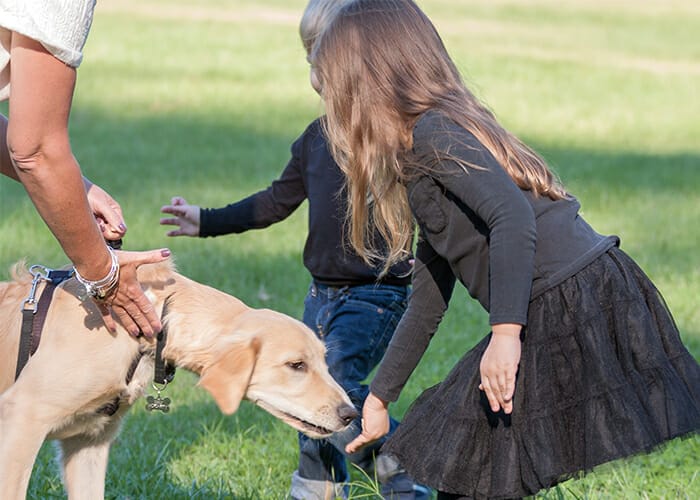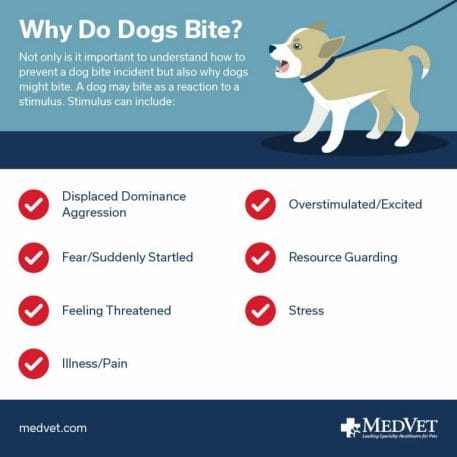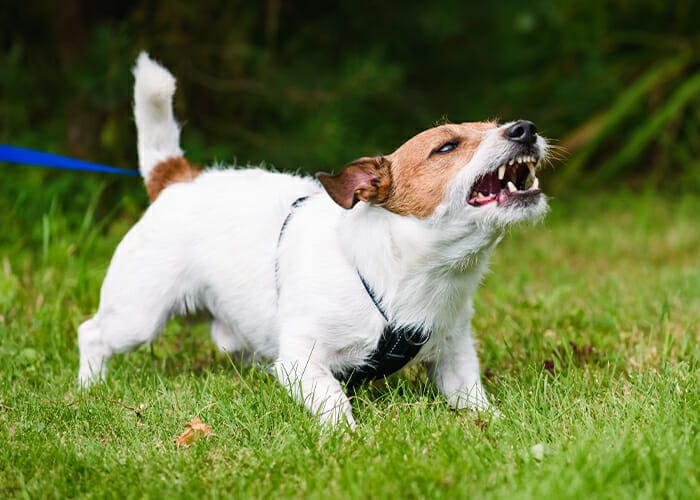Emergency Medicine, Urgent Care
Preventing Dog Bites – Tips for Protecting Your Loved Ones

According to the American Veterinary Medical Association (AVMA), there are 77 million dogs in the United States and approximately 38% of US households own at least one dog. The Centers for Disease Control and Prevention (CDC) and the Humane Society of the United States (HSUS) collected information indicating 4.7 million dog bites occur per year (this is an approximate ratio of 1 out of 73 people). Half of these bites involve children under the age of 16 who also tend to be more severely injured when bitten. These statistics show how important it is to educate others about preventing dog bites.
Any dog is capable of biting, whether it is a known family dog or an unknown stray wandering the neighborhood. Despite a differing of opinions, the propensity to bite is not directly related to a dog’s breed, size, or disposition. There is a saying among the veterinary community – if it has teeth, it is capable of biting. Even if the dog does not have a prior bite history. And while dog bites pose a serious health risk, fortunately, most bites can be prevented.
Why Dogs Bite
Before we look at preventing dog bites, we first need to understand why dogs might bite. A dog may bite as a reaction to a stimulus. Stimulus can include:
- Displaced dominance aggression – dominant to other dogs and gets aggressive with people
- Fear or suddenly startled – Loud noises or abrupt movements
- Feeling threatened – Being cornered or approached
- Guarding a person/toy/food – Known as ‘resource guarding’
- Illness or pain – Sudden or long-term illness, injury
- Overstimulated or excited – Rough play, tug games, rushing to greet a newcomer, boisterous play with other dogs
- Stress – Unfamiliar environment, noise, smells, situations, people, and other animals
Now that we know why dogs bite, let’s explore some of the ways you can reduce the chances of your dog biting.

Tips for Dogs in Your Care
There are steps you can take to ensure the pets you have in your home are a good fit for your family and decrease the chances that they will show aggressive behavior.
- Selecting the right dog. Be careful when selecting a dog and keep in mind personality, size, age, activity level, and maintenance requirements. Be realistic about matching the pet to your family’s lifestyle.
- Take time for training. Enroll in positive reinforcement training classes with certified trainers. Having the whole family take part in these classes will ensure that everyone is on the same page with training techniques, as well as build a strong relationship foundation for the pet/human bond.
- Socialize your pet. Appropriately (and safely) socialize the pet by frequently exposing them to various environments, people, and other pets. Always ensure your pet is on a traditional (i.e. leather or nylon webbed) 4’ to 6’ leash. Retractable leashes are not recommended because it is more difficult to keep your pet close and in control!
- Exercise your dog regularly. Dogs should receive regular exercise to include daily walks, interactive play with the owner/family, and playing with puzzle toys and games that stimulate mental well-being.
- Protect your pet’s health. Ensure the pet is evaluated by a licensed veterinarian on an annual basis, is kept up to date on vaccinations, and receives monthly heartworm, flea, and tick prevention year-round. Pets should also be spayed/neutered to decrease the potential of reproductive cancers and health issues, as well as to lower the possibility of hormone-induced aggression.
Understanding A Dog’s Language
Dogs can’t use words to tell us what they are feeling. Instead they show us through their behavior. Learning more about how dogs communicate can help us understand when a dog might be open to interacting with us. Knowing when dogs want to engage is helpful in preventing dog bites.
Verbal clues can include:
- Barking – note the difference in tone and pitch
- Growling or biting
- Showing teeth – note there’s a difference between a dog ‘smiling’ which is a submissive behavior and a dog lifting its lips in an aggressive manner
- Yawning or lip licking
Nonverbal clues can include:
- Body position in a stiff and rigid stance, sometimes with lunging
- Ears pinned back
- Head position remains stiff and focused with an intense and piercing stare
- Lips raised while baring teeth
- Ridge of hair on the neck and back (also known as hackles) prominently raised
- Tail held high and rigid
- Whites of the eyes expressly visible because the pupils are fixated on the object of fear or aggression even if the animal turns their head (also known as “whale eyes”)

Appropriate Interactions with Dogs
Learning to respect a dog’s space is important for everyone, especially children.
- Leave dogs alone when they’re eating, playing with a toy, sleeping, or seeking out their crate or quiet space.
- Do not treat your dog as playground equipment, toys, or a piece of furniture; no one should roll around or lean on, climb on, ride, or sit on a dog.
- If a pet walks out of a room or struggles when being held, allow them their freedom. It means they’re feeling uncomfortable and overwhelmed in that moment and want their space.
- Pets should be spoken to in a kind, gentle voice.
- Never strike your pet with your hand or other object.
- Teach children to always be gentle when touching a pet; they should not hit, pinch, poke them or pull on their fur, ears, or tail. They should not place their face close to a pet’s face.
Approach All Dogs with Care
Knowing when and how to safely approach a dog is another important step to preventing dog bites. Even dogs that are typically friendly could become aggressive in certain situations, and it’s always better to be safe than sorry.
- Do not approach or attempt to pet a dog if it’s not with an owner.
- Never reach over or through a fence to pet a dog.
- Do not approach a barking or growling dog.
- Ask the owner for permission to pet their dog and be gracious if their answer is ‘no.’ You should also never pick up or hold another owner’s pet unless given permission to do so.
- Teach children to stand quietly with their hands clasped in front of them when a dog approaches them. A child running and screaming toward a dog can provoke it to attack. They should not bend down and put their face next to a dog’s face either as that is the most common cause of facial bites in children. Children should receive permission from an owner before petting a dog and should only be allowed permission if the child’s caretaker is nearby to observe the interaction.
- Give female dogs space with their puppies. Disturbing a mom resting with or nursing puppies can cause her to be anxious about your presence and protective of her babies.
- Approach sick or injured dogs with caution. If a pet becomes sick or injured, requiring immediate emergency veterinary care, a temporary makeshift muzzle may be necessary when initially moving the pet to a vehicle. You can fashion a muzzle from a scarf, pantyhose, sock, necktie, bandage gauze, or other soft material.
- Never leave pets and children alone together, especially children under the age of 12. An infant or toddler should not be left unattended on the floor or furniture when there is a dog present, even if it’s “just for a second” or the dog has previously been observed to be gentle or indifferent toward the child. It only takes a second for a regrettable incident to take place.
Prevention is Possible
Whether a dog is familiar to you or not, it’s important to remember that dog bites can happen. Keeping these tips can help prevent dog bites from happening.
Sources:
- American Veterinary Medical Association: https://www.avma.org/resources-tools/pet-owners/dog-bite-prevention
- American Veterinary Medical Association: https://www.avma.org/about/dog-bite-prevention.aspx/teaching-children-how-prevent-dog-bites
- Canine Journal: https://www.caninejournal.com/dog-bite-statistics/
- First Aid for Pets: https://firstaidforpets.net/guide-muzzle-your-dog/